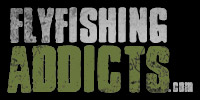REALTIME FLOWS  U. Kern: n/a cfs
U. Kern: n/a cfs
 L. Kern: 1341 cfs
L. Kern: 1341 cfs
 E.W: 312 cfs
E.W: 312 cfs
 U. Owens: 108 cfs
U. Owens: 108 cfs  L. Owens: 496 cfs 09/02/19 1:15 PM PST
L. Owens: 496 cfs 09/02/19 1:15 PM PST
choosing flies
11 posts
• Page 1 of 1
choosing flies
I need some help on figuring out what flies to use and when. For example how do you know when to use a midge or nymph or when to go to a dry fly, or what other options there are thanks for the help
- jbm78
- Posts: 73
- Joined: December 7th, 2009, 8:29 pm
- Location: bakersfield, ca
Re: choosing flies
Eeny, meany, miny moe, catch a rithrogena by the toe.................
Seriously. it depends on the water you're fishing and what's hatching, or what types of forage are in the water. No pat answer on this one. If I'm fishing a new water, I turn over rocks, check out the insect larva under them, looks for hatching insects, check for minnows, crayfish, etc.. Match the size and colors of the minnows to streamers. Match the size/color of stoneflies to my flies. Match the midge coloration/size to flies, etc. In other words--be observant, very observant. It also helps to do your research. Call the local fly shop, google the watershed and look at its hatch history, check guide reports, etc.
Gosh isn't this fun?
Seriously. it depends on the water you're fishing and what's hatching, or what types of forage are in the water. No pat answer on this one. If I'm fishing a new water, I turn over rocks, check out the insect larva under them, looks for hatching insects, check for minnows, crayfish, etc.. Match the size and colors of the minnows to streamers. Match the size/color of stoneflies to my flies. Match the midge coloration/size to flies, etc. In other words--be observant, very observant. It also helps to do your research. Call the local fly shop, google the watershed and look at its hatch history, check guide reports, etc.
Gosh isn't this fun?
"Should you cast your fly into a branch overhead or into a bush behind you, or miss a fish striking, or lose him,or slip into a hole up to your armpits-keep your temper; above all things don't swear, for he that swears will catch no fish."
-

midger - Posts: 3356
- Joined: August 14th, 2008, 9:47 am
- Location: Idaho
Re: choosing flies
I normally fish the easter waters. Just confusing standing there at the water looking through the flies having no idea what to choose so im just trying to get an idea thankks guys
- jbm78
- Posts: 73
- Joined: December 7th, 2009, 8:29 pm
- Location: bakersfield, ca
Re: choosing flies
If you're talking Eastern as in Eastern sierras, then a silver bead black zebra in a size 18-22 is hard to beat (also easy to tie). Others that consistently produce are the Pheasant tail in sizes 16-18, Copper Johns in sizes 14-18, emergers like the RS2 in sizes 18-24, parachute adams in sizes 14-20, Black ants on sizes 16-20, and so forth. Streamers like wooly buggers, punk perch, meat whistles, circus peanuts, etc. There are lots of patterns that will produce if you fish them properly.
I'm convinced that presentation is generally more important than the actual fly in the majority of cases.
I'm convinced that presentation is generally more important than the actual fly in the majority of cases.
"Should you cast your fly into a branch overhead or into a bush behind you, or miss a fish striking, or lose him,or slip into a hole up to your armpits-keep your temper; above all things don't swear, for he that swears will catch no fish."
-

midger - Posts: 3356
- Joined: August 14th, 2008, 9:47 am
- Location: Idaho
Re: choosing flies
Thanks for the tips, so do you basically try what you have, I mean if your not doing any good on dries how do you know to try a zebra midge instead of an rs2 etc. etc. i appreciate your help midger
- jbm78
- Posts: 73
- Joined: December 7th, 2009, 8:29 pm
- Location: bakersfield, ca
Re: choosing flies
Midger hit the nail on the head! No need to elabarate.
Here is a reference for hatch charts that may help in the future. Also shows which flies resemble the insects.
http://stevenojai.tripod.com/
Very good site play around with it and you will find a wealth of info.
Artin
Here is a reference for hatch charts that may help in the future. Also shows which flies resemble the insects.
http://stevenojai.tripod.com/
Very good site play around with it and you will find a wealth of info.
Artin
ethics is something you do when no one is watching
-
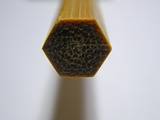
Artin - Posts: 1284
- Joined: August 15th, 2009, 3:12 pm
Re: choosing flies
the first thing that i do when i get to the river , before i even rig my rod ,is take out my sein net( 3ft. by 2ft. piece of window screen w/ a pole on each side) find a shallow chute or seam and screen the water to see what is floating down stream. then check rocks and weeds to see what is there. what ever i find in the drift is what i will try to match first.
if you see rising fish try to determine if they are taking flies off of the surface or just under it. off the surface is pretty easy, you will see a nose, or there will be a bubble left on the surface,if they are taking bugs just under the surface, emerging nymphs or pupa ,
it will be sort of a bulge or boil. most times for me,even during a hatch i will fish a nymph or emerger in the film or just below it tied to the bend of a dry fly.
figuring out what the critters are eating is half the fun.
mike
if you see rising fish try to determine if they are taking flies off of the surface or just under it. off the surface is pretty easy, you will see a nose, or there will be a bubble left on the surface,if they are taking bugs just under the surface, emerging nymphs or pupa ,
it will be sort of a bulge or boil. most times for me,even during a hatch i will fish a nymph or emerger in the film or just below it tied to the bend of a dry fly.
figuring out what the critters are eating is half the fun.
mike
-

duckdog - Posts: 693
- Joined: April 13th, 2009, 8:32 pm
- Location: Oceanside ,Ca
Re: choosing flies
Interestingly enough my go to fly for the dry is the attractor... royal Wulff size 20. It usually will bring me fish when they rise. Midges are good all year long. Double that with a classic nymph (Prince, PHT, Red Squirrel Tail)
Search this site for archives best flies. I suggest we develop a list with the 5 most popular flies in each catagory. (I know we've been through this.)
Search this site for archives best flies. I suggest we develop a list with the 5 most popular flies in each catagory. (I know we've been through this.)
EVERY DAY A VICTORY, EVERY YEAR A TRIUMPH
- fflutterffly
- Posts: 1787
- Joined: March 16th, 2008, 6:50 am
- Location: Los Angeles, CA
Re: choosing flies
jbm78 wrote:Thanks for the tips, so do you basically try what you have, I mean if your not doing any good on dries how do you know to try a zebra midge instead of an rs2 etc. etc. i appreciate your help midger
The key is to observe, observe, observe. Look for any surface action and see what type of rises they are. Large splashy rises where you see the noses means they're taking flies off the surface that are floating. Swirls near the surface where you see the tails usually means they're taking the emergers in the surface film/meniscus. Nothing rising usually means they're feeding down deeper or not at all. In this case you need to flip rocks, screen the flows, check the subsurface weeds, etc to see what is in the stream. Look for cased caddis crawling, grammarus (scuds) in the subsurface weeds, stonefly and mayfly nymphs under rocks. Check the shoreside bushes and vegetation to see what insects are hanging out. Ants? Beetles? Stoneflies? Mayflies? Caddis?
Note their colors and sizes and tie on flies accordingly to match what you find. If fish are feeding deep, I don't just blindly cast dry flies hoping something will look up. I tie on a heavily weighted nymph with a midge dropper and bounce the rig right on the bottom. If I notice swirling surface takes, I'll tie on a dry with an emerger trailer. The dry is my indicator, but often fish will take it as well.
There is no one set pattern you can go to in all instances, but you can generally entice fish with a Prince, birdsnest, Hare's ear, Muskrat or some similar generic nymph as a point fly and then adding a midge type dropper--like a Zebra, Mercury, WD-40, Beaded RS2. I switch flies often if I'm not getting any action on what I'm throwing, and change flies accordingly as the situation changes or the hatch starts.
For example, this weekend, the fish weren't hitting my zebra midge, probably because there wasn't a lot of midge activity. There was, however, a lot of caddis walking on the shoreside vegetation, which meant there was probably subsurface caddis activity. There was not active caddis hatch, so I tied on a tung bead caddis emerger soft hackle with a micro prince dropper below it. It was game on until the caddis started popping, then I switched to a small dark colored caddis dry with a larger Elk n CDC trailer--both surface flies. Still game on until I couldn't pick my flies out from the 1000's of other caddis floating the foam line. Switched to a parachute posted caddis with an emerging caddis trailer in the film, and once I could see my fly (the parachute) again, continued to draw fish. The parachute acted as an indicator for when fish took the emerger, which was about 50/50.
Here are the flies used during this progression:
MicroPrince (gold beadhead worked better than the black):
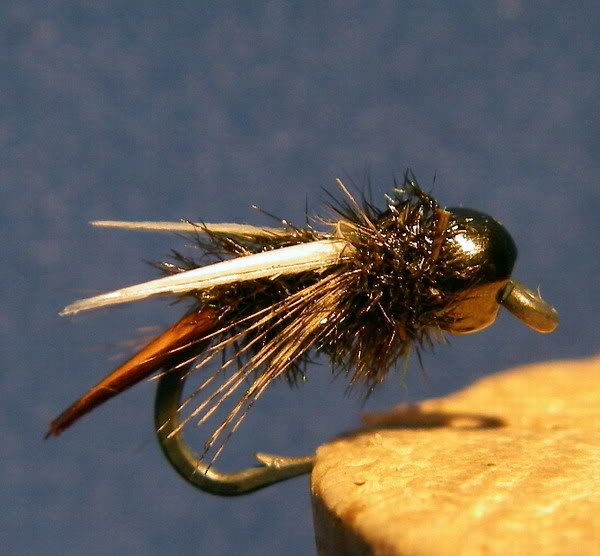
Once the caddis started popping:

Once I couldn't pick out the standard caddis from their brothers, this as a point fly and the emerger as a trailing fly:
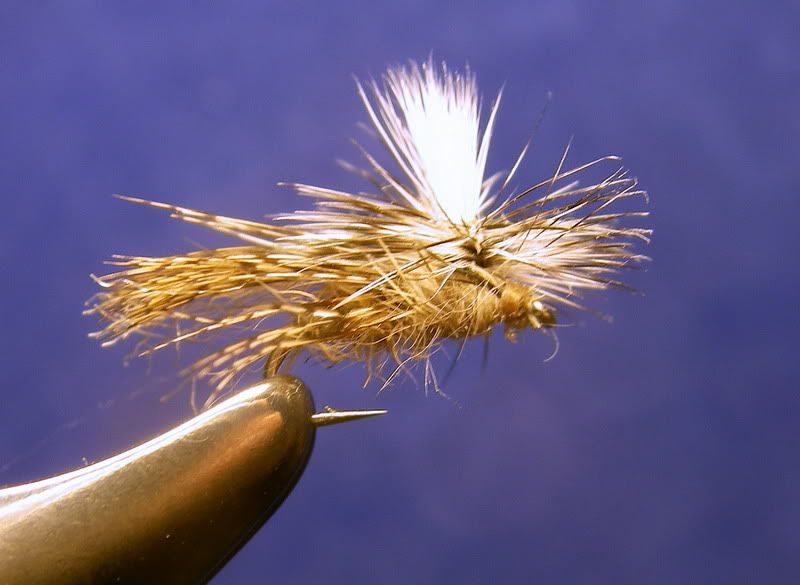

Bottomline: there is no "right" way, or the "right" flybox. Just observe and see what works. If what you're doing isn't working, switch gears, change flies, change tactics, and show them something different that you think they might like. Trust me, it will click eventually.
"Should you cast your fly into a branch overhead or into a bush behind you, or miss a fish striking, or lose him,or slip into a hole up to your armpits-keep your temper; above all things don't swear, for he that swears will catch no fish."
-

midger - Posts: 3356
- Joined: August 14th, 2008, 9:47 am
- Location: Idaho
Re: choosing flies
Midger,
Those flies are very nice.... You have a really great *! I really like the micro price btw. I think I will tie some up. Good tips as well.
Artin
Those flies are very nice.... You have a really great *! I really like the micro price btw. I think I will tie some up. Good tips as well.
Artin
ethics is something you do when no one is watching
-

Artin - Posts: 1284
- Joined: August 15th, 2009, 3:12 pm
Re: choosing flies
Oh, and don't forget to carry a box of streamers. Chop your tippet length back to 4-5 feet total at a 1-2X and tie on some "meat". Use aheavier weight rod and chuck to the banks, and strip, strip strip. Many kinds of streamers work, I'm partial to these:
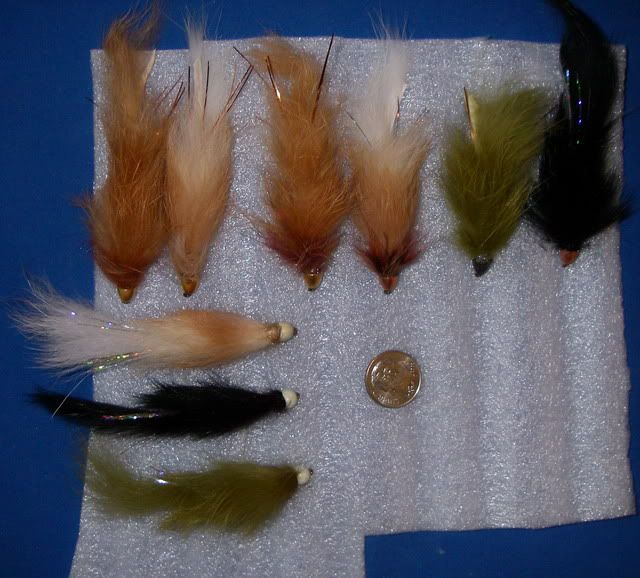
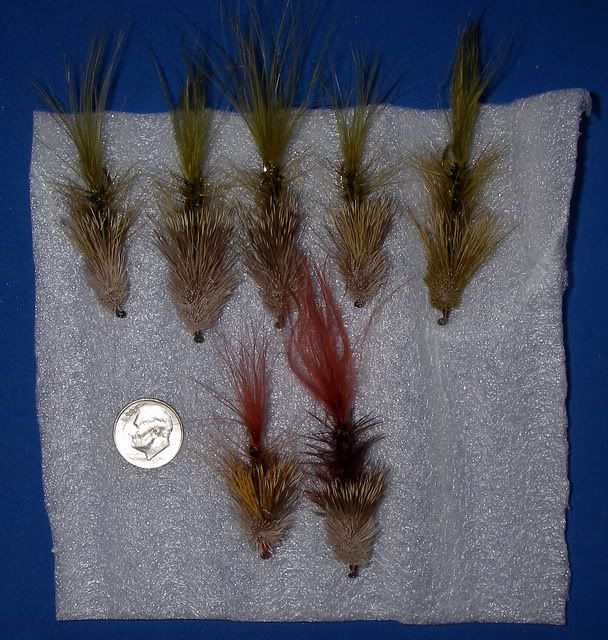
Circus Peanut

Meat Whistle
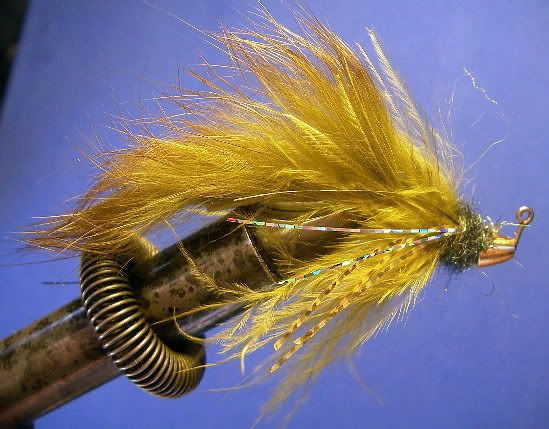
And of course your standard wooly buggers in all flavors. Most of the Eastern streams don't require a sink tip, but you may have to add some splitshot if your flies aren't weighted.


Circus Peanut

Meat Whistle

And of course your standard wooly buggers in all flavors. Most of the Eastern streams don't require a sink tip, but you may have to add some splitshot if your flies aren't weighted.
"Should you cast your fly into a branch overhead or into a bush behind you, or miss a fish striking, or lose him,or slip into a hole up to your armpits-keep your temper; above all things don't swear, for he that swears will catch no fish."
-

midger - Posts: 3356
- Joined: August 14th, 2008, 9:47 am
- Location: Idaho
